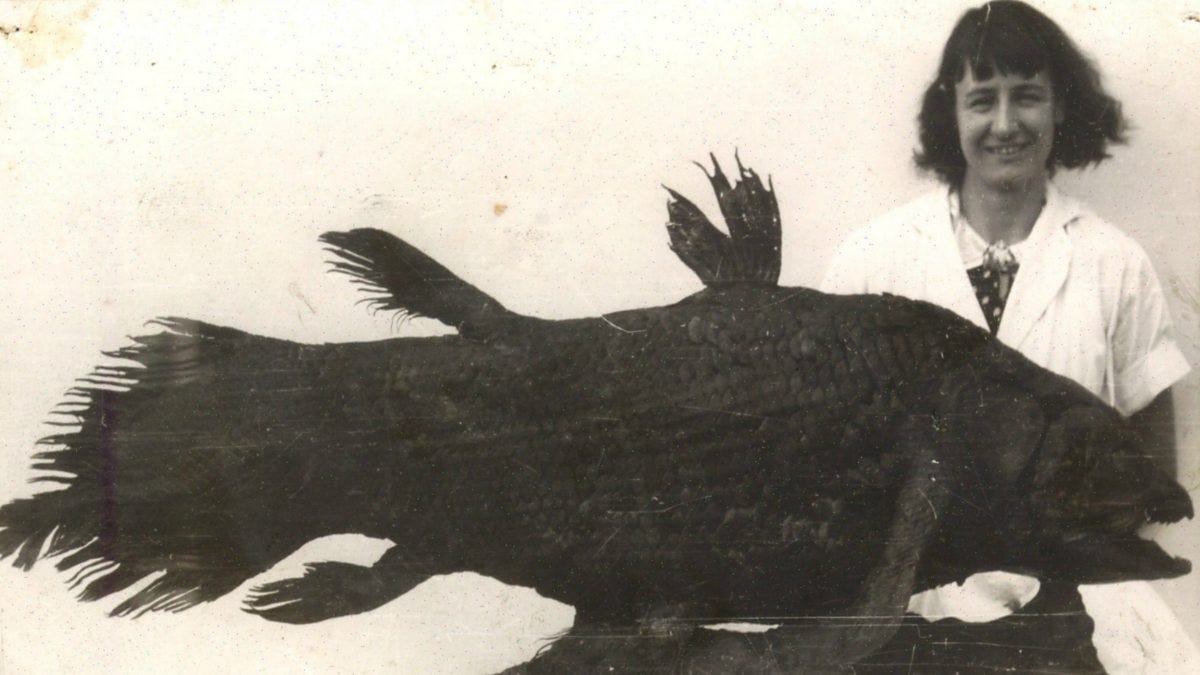Lazarus taxon
"I picked away at the layers of slime to reveal the most beautiful fish I had ever seen."

The video is grainy, but its contents are unmistakable. It’s a clearing on the rainforest floor, backdropped by a thicket of spindly trees. A few patches of green foliage sprout up from the dirt. A small, brown creature emerges from the right of the screen. Its movements are cautious., its head darting left and right before taking its first step toward the center of the frame, eyes glowing from the camera.
The movements are jerky, like an animation with too frames to approximate natural motion. Four seconds in, its pointed head lifts up and the animal appears to stare directly at the camera for half a second. It drops down again, returning to sniff the ground with a sharp snout. The creature continues on its path, finally walking out of frame.
The footage is a “camera-trap,” a morbid name for an unobtrusive, motion-activated video camera designed to capture footage of wildlife, without disturbing it in the process. The videographers have not released the exact location of the footage, for fear of the provoking the use of the far more violent snare traps used by hunters in the area.
At first glance, it’s a dull 30 seconds of video. The subject is only on screen for a third of that extremely short run-time. But the star (alternately described as the size of both a rabbit and house cat) was enough to garner it a published piece in Nature titled “Camera-trap evidence that the silver-backed chevrotain Tragulus versicolor remains in the wild in Vietnam.”
That, in turn, earned it international news coverage.
The video represents the first officially logged appearance of the small, deer-like animal in nearly 30 years (though local reports have notably surfaced here and there). When it emerged in late-2019, it was the first time the Vietnam mouse-deer had been officially recorded — either alive or dead — since a 1990 Vietnamese-Russian expedition. Prior to that, the animal’s last appearance was the first time it had officially described by scientists, when a British zoologist officially noted the species based on four animals likely acquired by local hunters. That was 1910.
Named for the follower resurrected by Jesus in the Gospel of John, a Lazarus taxon is a species, family or class of organisms that disappear, only the reemerge after some extended period. In paleontology, the concept applies to the fossil record. Though such gaps can sometimes be chalked up to the exceedingly small percent of organisms that are ultimately fossilized. Harder to explain are those living animals that have managed to avoid observation for decades-long stretches.
But perhaps strangest and most notable of all are those organisms that split the difference, disappearing from the fossil record only to to reemerge in the flesh. The coelacanth is almost certainly the best-known example of that specific phenomenon. The prehistoric fish was discovered by Marjorie Courtenay-Latimer while hunting for unusual specimen among a local fisherman’s catch. "I picked away at the layers of slime to reveal the most beautiful fish I had ever seen," the South African museum official said of her find.
She alerted ichthyologist J. L. B. Smith, who recognized drawings of the then-taxidermied fish for what they were: a taxon that had disappeared from the fossil record, some 66 million years prior. He replied with a flabbergasted wire, "MOST IMPORTANT PRESERVE SKELETON AND GILLS = FISH DESCRIBED.” Smith would go on to bestow the species with the scientific name Latimeria chalumnae, in honor of Courtenay-Latimer and South Africa’s Chalumna River, where the fish had been found.
The concept of Lazarus taxon is not particularly well-defined. Scientists often disagree about the particulars. Importantly, however, it should not be conflated with the related but distinct concepts of Elvis (organisms similar to extinct species due to convergent evolution) and zombie taxons (a washed out fossil that has been redeposited into much younger rock).
Sources:
Assessing the completeness of the fossil record using brachiopod Lazarus taxa: https://ui.adsabs.harvard.edu/abs/2012AGUFM.B11A0387G/abstract
Coelacanth Latimeria: https://ocean.si.edu/ocean-life/fish/coelacanth
The Man Who Swims With Coelacanths: https://www.wired.com/2011/05/hans-fricke/
Missing for 30 Years, a Rare Deer Species Is Rediscovered in Vietnam: https://www.popularmechanics.com/science/animals/a29752629/silver-back-chevrotain/


